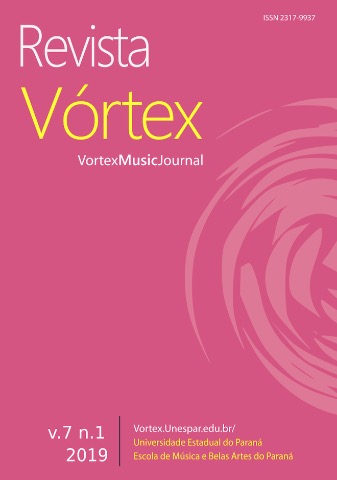Kirchner and Time – An Analysis of Linear and Nonlinear Time in Leon Kirchner's Interlude I
DOI:
https://doi.org/10.33871/23179937.2019.7.1.2670Resumo
This article aims to analyze temporality in Leon Kirchner's Interlude I for solo piano, in light of Jonathon Kramer's book The Time of Music. The first section serves as an introduction to the composer – his biography, influences, and compositional style. The following section introduces Jonathon Kramer's book and his concepts of linear and nonlinear time in music. Thereafter an analysis of aspects of the Interlude's linear time, as defined by Kramer, is presented, including linearity manifest through developing variation, step-wise motion, tonal references, changes in tempo, flexion count changes, and transpositions. The next section seeks to examine manifestations of nonlinear time in the Interlude, such as balance and recapitulation, and discusses the implications of Kramer's nonlinear moment time. The conclusion summarizes interactions between linearity and nonlinearity in the Interlude.
Downloads
Referências
BAKER, James. M.; BEACH, David; and BERNARD, Jonathon. W. Music Theory in Concept and Practice. Rochester, NY: University of Rochester Press, 1997.
BASS, Richard. Models of Octatonic and whole-tone interaction: George Crumb and his predecessors. Journal of Music Theory, vol. 38, no. 2, p. 155- 186, fall 1994.
DELAERE, Mark. Tempo, Metre, Rhythm: Time in Twentieth Century Music. In: Unfolding Time: Studies in Temporality in Twentieth-Century Music, edited by Darla Crispin, Leuven University Press, 2009, pp. 13–44.
ELIOT, T.S. Little Gidding. Available at: www.columbia.edu/itc/history/winter/w3206/edit/tseliotlittlegidding.html. Accessed 4 May, 2018.
FEISST, Sabine. Schoenberg's New World: The American Years. New York, NY: Oxford University Press, 2011.
GROUT, Donald Jay, and Claude V. PALISCA. A History of Western Music. Fourth ed., New York, NY: W.W. Norton and Company, Inc., 1988.
Interlude. Webster's New Universal Unabridged Dictionary. Barnes Noble Books, 1996.
KIRCHNER, Leon. Composer/Pianist Leon Kirchner: a Conversation with Bruce Duffie, Dec. 16, 1990. Interview. Available at: http://www.bruceduffie.com/kirchner.html. Accessed: 31 Oct. 2017.
______. Interlude I. New York, NY: Associated Music Publishers, Inc, 1989. 1 score. Piano.
KRAMER, Jonathon D. The Time of Music. New York, NY: Schirmer books, 1988.
RIGGS, Robert. Leon Kirchner: Composer, Performer, and Teacher. Rochester: University of Rochester Press, 2010.
RINGER, Alexander L. Leon Kirchner. In: Grove Music Online, 2005. Available at: http://www.oxfordmusiconline.com/public/book/omo_t237. Accessed: 12 Jul. 2017.
______. Leon Kirchner. Musical Quarterly, vol. 43, no. 1, p. 1-20, 1957.
SCHOENBERG, Arnold. Coherence, Counterpoint, Instrumentation, Instruction in Form. Editor: S. Neff. Translation: C. Cross. Lincoln and London: University of Nebraska Press, 1994.
______. Fundamentals of Musical Composition. Editors: G. Strang and L. Stein. New York, NY: St. Martin"™s Press, 1967.
______. The Musical Idea and the Logic, Technique and Art of Its Presentation. Editor: Patricia Carpenter and Severine Neff, Indiana University Press, 2006.
______. Style and Idea. Translation: E. Stein and L. Black. New York, NY: St. Martin"™s Press, 1975.
SIMMS, Brian R. Music of the Twentieth Century: Style and Structure. Belmont, CA: Thompson Learning, 1996.
SWART, Inette. An analysis of For the Left Hand by Leon Kirchner with specific reference to the use of the octatonic scale. Thesis (Master of Music)"”Music Department, University of Pretoria, Pretoria, South Africa 2005. Available at: http://www.repository.up.ac.za/dspace/bitstream/ handle/2263/25271/00dissertation.pdf?sequence=1>. Accessed: 12 July 2017.
TOMMASINI, Anthony. Leon Kirchner, Composer and Teacher, Dies at 90. The New York Times, 17 Sept. 2009. Available at: www.nytimes.com/2009/09/18/arts/music/18kirchner.html?mcubz=1. Accessed: 3 May 2018.
TRUE, Nelita. A style analysis of the published solo piano music of Leon Kirchner. 1976. Dissertation (Doctorate of Music)"”Peabody conservatory of music, Johns Hopkins University, Baltimore, Maryland 1976.
WEBERN, Anton. The Path to New Music. Bryn Mawr, PA: Theodore Presser Company, 1963.
Downloads
Publicado
Como Citar
Edição
Seção
Licença
Copyright (c) 2021 Adriana Jarvis Twitchell, Guilherme Sauerbronn Barros

Este trabalho está licenciado sob uma licença Creative Commons Attribution 4.0 International License.
Autores mantêm os direitos autorais e concedem à revista o direito de primeira publicação, com o trabalho simultaneamente licenciado sob a Licença Creative Commons Attribution que permite o compartilhamento do trabalho com reconhecimento da autoria e publicação inicial nesta revista.






